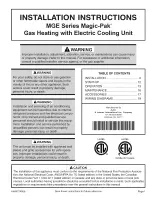
14 • Residen al Standard Gas Water Heater Use and Care Guide
INS
TALLA
TION
14 • Residen al Standard Gas Water Heater Use and Care Guide
INSTALLATION
Step 1:
✓
Verify that your
home is equipped
and up-to-date for
proper opera on
Installing a new water heater is the
perfect me to examine your home’s
plumbing system and make sure the
system is up to current code stan-
dards. There have likely been plumb-
ing code changes since the old water
heater was installed. We recommend
installing the following accessories
and any other needed changes to
bring your home up to the latest code
requirements. Upda
ng your plumb-
ing system can help extend the life of
your water heater, avoid damage to
your home and property, and reduce
the risk of serious injuries or death.
Inspect your home and install any de-
vices you need to comply with current
codes and assure that your new water
heater performs at its best. Check
with your local plumbing o
ffi
cial for
more informa on.
✓
Water pressure
Most codes allow a maximum
incoming water pressure of 80 psi
(we recommend a working pressure
no higher than 50-60 psi). Check your
home’s water pressure with a pressure
gauge and adjust if necessary. High
water pressure can damage the water
heater, piping, and other appliances.
HOW:
Purchase an inexpensive water
pressure gauge from Lowe’s®. Con-
nect the water pressure gauge to
an outside faucet and measure the
maximum water pressure experienced
throughout a 24-hour period (highest
water pressures o en occur at night).
Figure 12 -
Use a Water Pressure Gauge to make
sure your home’s water pressure is not too
high.
To adjust your home’s water pressure:
Locate your home’s Pressure Reduc-
ing Valve (PRV) on the main incoming
(cold) water supply line and adjust the
water pressure control to between
50 and 60 psi. If your home does not
have a Pressure Reducing Valve, install
a PRV on the home’s main water sup-
ply line and set it to between 50 and
60 psi. Pressure Reducing Valves are
available at Lowe’s®.
BACKGROUND:
Over the years, many
u li es have increased water supply
pressures so they can serve more
homes. In some homes today,
pressures can exceed 100 psi. High
water pressures can damage water
heaters, causing premature leaks. If
you have replaced toilet valves, had a
water heater leak, or had to repair
appliances connected to the plumbing
system, pay par cular a en on to
your home’s water pressure. When
purchasing a PRV, make sure the PRV
has a built-in bypass.
✓
Wa-
ter pressure
in-
crease caused by ther-
mal expansion
Verify that you have a properly sized
Thermal Expansion Tank. We recom-
mend installing an expansion tank if
your home does not have one. Plumb-
ing codes require a properly pressur-
ized, properly sized Thermal Expan-
sion Tank in almost all homes.
Figure 13 -
A Thermal Expansion Tank helps
protect the home’s plumbing system from pres-
sure spikes.
HOW:
Connect the Thermal Expansion
Tank (available from Lowe’s® .) to the
cold water supply line near the water
heater. The expansion tank contains
a bladder and an air charge. To work
properly, the Thermal Expansion Tank
must be sized according to the water
heater’s tank capacity and pressurized
to match the home’s incoming water
pressure. Refer to the instruc ons
provided with the Thermal Expansion
Tank for installa
on details.
BACKGROUND:
Water expands when
heated, and the increased volume
of water must have a place to go, or
thermal expansion will cause large
increases in water pressure (despite
the use of a Pressure Reducing Valve
in the home’s main water supply line).
The Safe Drinking Water Act of 1974
Summary of Contents for G9-T5040NVR
Page 31: ...Residen al Standard Gas Water Heater Use and Care Guide 31 NOTES NOTES ...
Page 32: ...32 Residen al Standard Gas Water Heater Use and Care Guide NOTES NOTES ...
Page 33: ...Residen al Standard Gas Water Heater Use and Care Guide 33 NOTES NOTES ...
Page 34: ...34 Residen al Standard Gas Water Heater Use and Care Guide NOTES NOTES ...















































